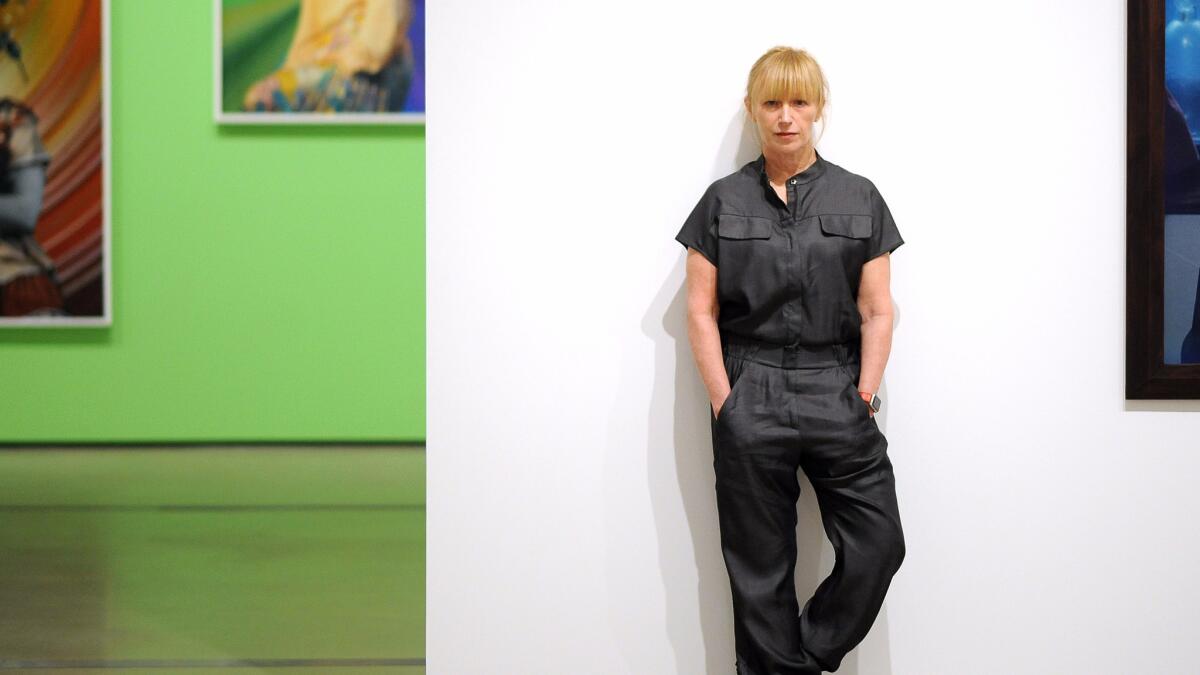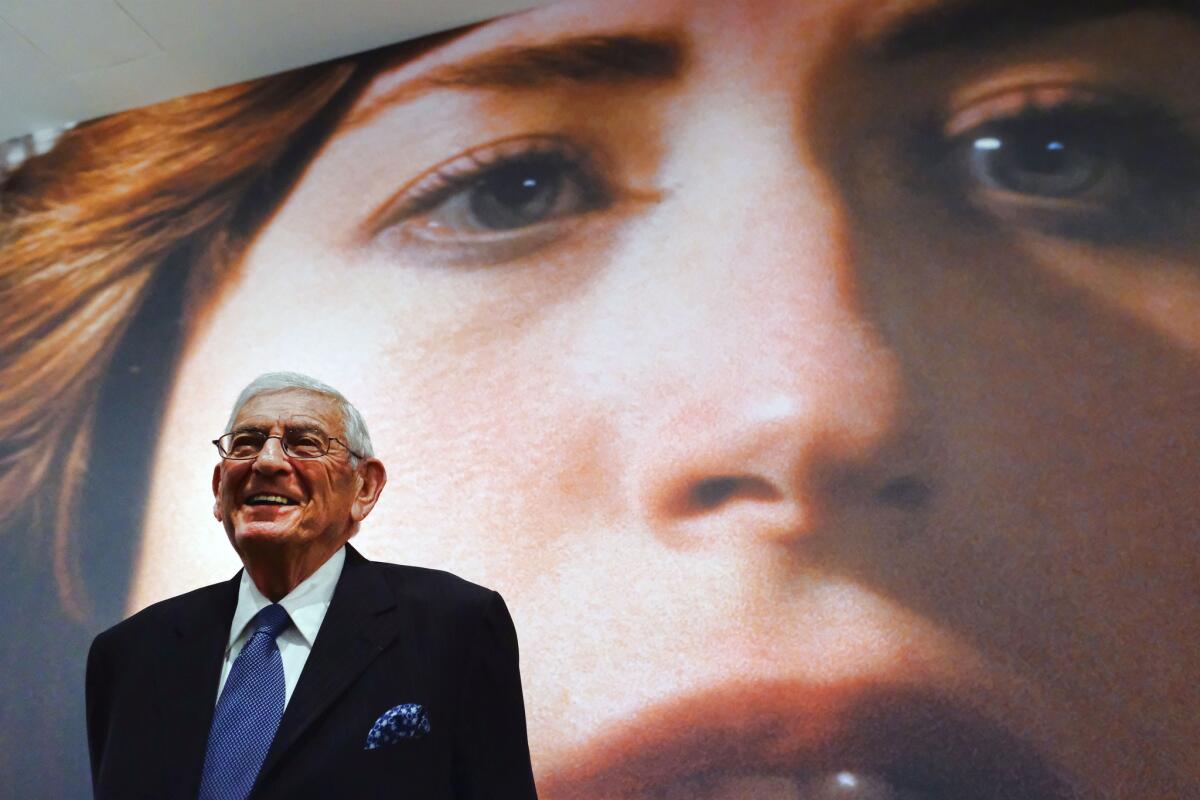Cindy Sherman reveals her latest body of work — and itâs personal

In a cavernous Broad museum gallery devoid of people, Cindy Sherman appears as if she has leaped from one of her large-scale, cinematic photographs â or one of the photographs has engulfed her.
Dwarfed beneath her new, ginormous wall mural depicting a dreamy face, a reimagining of one of her early â80s rear-screen projection images, Sherman could be passing through a noirish Hollywood soundstage. Like her untitled photographs â a choice meant to open the images to interpretation â Sherman, too, is a blank canvas of sorts this morning, in a plain gray jumpsuit and not a scrap of makeup, her blond hair pulled into a slender ponytail. But, like all of her storied images, thereâs a twist: Sheâs balancing herself on crutches. Like her fidgety, in-transit bus riders in one series or the pensive suburban housewife twisting her hair in another, the petite woman with the broken foot bone suggests off-screen drama, a backstory.
For decades, Sherman insisted the characters she embodies in her photographs had nothing to do with her, that they were simply amplifications of female media tropes. Now 62, and with a major survey exhibition opening at the Broad on Saturday, the art star admits thereâs something of Sherman in all of her latest characters, and thereâs something of them in her.
âItâs a big step,â Sherman says of her newest work, fictional portraits of aging, former â20s-era silent film divas. âI still donât feel theyâre me, but I donât feel like Iâm hiding in them and trying to disappear within the characters the way Iâve been in the past. Iâm more present with these characters, Iâm like one of them.â
Sherman is leading a private walk-through of the Broadâs âCindy Sherman: Imitation of Life,â a loosely chronological survey of more than 120 photographs created over 40-plus years. The exhibit, which practically fills the first floor of the Broad, is Shermanâs first major museum show in L.A. in nearly 20 years, and the Broadâs first special exhibition since opening in September. Eli and Edythe Broad are among the earliest collectors of Shermanâs work, and the museum boasts the largest collection of the artistâs work worldwide. All but 18 of the museumâs Sherman pieces will be on view.

As a performative photographer, Sherman spends hours alone in her studio meticulously layering on wigs, prosthetics, false eyelashes, face makeup and vintage frocks to embody societal, pop cultural and cinematic tropes bestowed upon women â the young, vulnerable B-movie starlet, the sexy but confined â50s housewife, the disaffected and aging socialite, even archetypes from Renaissance and Baroque paintings. Her very private, behind-the-scenes practice of identity play is as much a part of the final work as the photographic image itself. As Sherman obliterates herself and re-surfaces in a chameleonic array of characters, she not only illuminates the fluidity of identity itself but probes our collective identity as it surfaces in mass media.
âSheâs one of the most significant contemporary artists working today,â museum director Joanne Heyler says, adding that Shermanâs images â which landed her in both the prestigious German art exhibition Documenta 7 and the Venice Biennale in 1982, when she was just 28 â resonate beyond the art world and the decade in which they were created because they speak to such universal, charged issues.
âImitation of Lifeâ incorporates all of Shermanâs major bodies of work from 1975-2016, including her early Hitchcock-inspired black and white film stills and color rear-screen projection images; her centerfolds series, originally commissioned in the â80s by Artforum and later rejected by the magazine for being too disturbing; the history portraits; the comically grotesque vomit and sex pictures; the desperate-seeming Hollywood and Hamptons ladies and New York socialites; and the manic clowns, presented salon style against a lime green wall.
Her latest work in the show â Shermanâs first new pictures in five years â embody whatâs been on her mind lately: filmmaking and aging. They depict richly colored, dolled up former silent film stars struggling to hang on to a vestige of their radiance and beauty. With their ornate hairstyles, severely drawn eyebrows and tightly wrapped turbans, they may or may not be the same fledging starlets of her film stills four decades ago. Thereâs no direct relationship between the two bodies of work, Sherman says, but theyâre connected in that the new photographs, which debuted at New Yorkâs Metro Pictures gallery in May, are a return to her early film inspiration.
âAnd possibly because itâs the most sincere work Iâve done since then, where I wasnât doing caricatures of people,â she adds. âIâm so much a part of these characters at this point of my life.â
Itâs only through the process of masquerading herself, Sherman says, that new work takes shape and themes arise. Inspired by images in a book about German Expressionism as well as by Norma Desmond from âSunset Boulevard,â she began playing with false eyelashes, outlandish hairdos and extreme makeup. When it came time to shoot, she says, using a high resolution camera that showed âa lot of imperfections,â and because it had been five years since sheâd last shot herself, âit was a little shocking to me,â Sherman says. âI realized my range had narrowed. Five years when youâre in your 60s makes a huge difference, when youâre suddenly looking at your face up close. I suddenly thought, âOh my God, now there are certain things I canât erase.ââ
Sherman did lightly tweak her images in Photoshop, but she also didnât want to dilute the struggle of the women in the pictures.
âI could have really made the hands look young and my neck toned, but I realized there had to be something there of these women and the lives they led,â she says.
Like all woman, aging is something Sherman struggles with personally, as well.
âItâs really hard,â she says. âIâm definitely torn between the possibility of doing something surgical and feeling like, âCome on, somebodyâs gotta age in a normal way that other young people can look up to and appreciate.ââ
Guest curator Philipp Kaiser has given the show a pointed, filmic framework. Sherman created two site specific murals that adorn the exhibition entrance, blown up to movie screen size. And the 1997 comedic horror movie Sherman directed, âOffice Killer,â plays on a loop in a black box theater. The exhibition title, Shermanâs choosing, is a reference to a 1959 Douglas Sirk melodrama, âImitation of Life,â itself a remake, or imitation, of a 1934 film â so the title also nods to the process-driven art appropriation movement that Sherman was part of.
âHer work is a meta-critique of our image saturated reality,â Kaiser says. âHer photographs are extremely theatrical. L.A. is the perfect place to show them â a city defined by the media and film industry.â
The Broads first encountered Shermanâs work in 1982 at Metro Pictures, then in SoHo, during a showing of her rear-screen projection series. âThe gallery invited us downstairs to look at some works from Cindyâs film still series,â Eli Broad recalled in an email. âWe werenât photography collectors, but there was something in her work that went beyond photography. I was mesmerized. It was all Cindy. We bought 20 of her works on the spot.â
That âImitation of Lifeâ is ticketed â $12 for visitors older than 17 â after much hype about the Broadâs free admission, has generated some controversy, especially given that about 90% of the works on display in the exhibition is from the museumâs permanent collection.
âWe invited a guest curator to bring a new point of view to bear on the achievements of Cindy Sherman â thereâs a catalogue, the site specific murals, loans,â Heyler says, the latter referring to 11 photographs on loan from the Whitney Museum of American Art, the Museum of Fine Arts, Houston, the Menil Collection, Metro Pictures. âThere are costs to putting together a show where youâre supporting a curatorial presence.â
Looking forward, Sherman says that nearly every time she thinks about work, she returns to the idea of filmmaking; sheâd like to write and direct another feature and is mulling possibilities.
âPart of the problem,â she says, âis Iâm not used to working with a crew or a narrative. But Iâm telling myself I can still work alone in my studio, the way I do with a still camera, just use it as a movie camera and experiment. Iâd consider it a great success if it were between John Waters and David Lynch.â
Sheâs still friendly with the actresses in âOffice Killer,â which starred starring Carol Kane, Molly Ringwald and Jeanne Tripplehorn, âso maybe weâd do a reunion,â she says, laughing.
Passing through the final gallery in the Broad exhibition, Sherman pauses at her latest pictures.
âI was thinking about how [hard] aging was for some of them,â she says softly, noting how Joan Crawford overdid her makeup to appear young and Greta Garbo hid from the public as she got older.
âAnd how sad that was. I just had a lot of empathy for them.â
------------
âCindy Sherman: Imitation of Lifeâ
Where: The Broad, 221 S. Grand Ave., Los Angeles
When: Saturday-Oct. 2; closed Mondays
Admission: $12 (advance tickets required)
Info: (213) 232-6200, thebroad.org
MORE:
What's drawing millennials to downtown L.A.'s Broad museum
Art as a mirror of selfie culture? That's 'Cindy Sherman: Imitation of Life'
UPDATES:
12:10 p.m.: This article was updated with additional details.
This article was originally published at 3 a.m.
The biggest entertainment stories
Get our big stories about Hollywood, film, television, music, arts, culture and more right in your inbox as soon as they publish.
You may occasionally receive promotional content from the Los Angeles Times.








